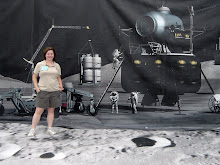
The first successful robotic lunar rover, Lunokhod 1, landed on 17 November 1970. For the next ten months the rover was driven by operators in the Soviet Union, with the total distance traveled exceeding 10 km. A French-built laser reflector was aboard rover, but after Lunakhod 1 fell silent on September 14, 1971, the location of the rover and retroreflector was unknown.
Laser retroreflectors are used by ground-based telescopes to pulse of laser light to the Moon and back. The time for the return tells the position of the retroreflector to less than a centimeter. This allows scientist to measure the shape or the moon as it bulges due to tides, the wobble of the Moon as it rotates on its axis, and the motion of the of Moon on its orbit to within an accuracy of one millimeter, or about the thickness of a paperclip. Three reflectors are required to lock down the orientation of the moon – the retroreflectors left by the Apollo 11, 14, and 15 missions are still routinely used for these measurements. Additional retroreflectors would allow determination of different lunar parameters and enable grater precision. Occasionally the Soviet Lunokhod 2 reflector has been used for this information, though it is severely degraded relative to the Apollo reflectors.
Ground-based observers had occasionally looked for the Lunokhod 1 reflector over the last two years, but faced tall odds against finding it until recently. The breakthrough came last month when the high-resolution camera on NASA’s Lunar Reconnaissance Orbiter, or LRO, obtained images of the landing site. The camera team, led by Mark Robinson at Arizona State University, identified the rover as a sunlit speck on the image (see below) —miles from where teams had been searching. On April 22, Tom Murphy at UCSD and his team used the 3.5 meter telescope at the Apache Point Observatory in New Mexico to find the long lost Lunokhod 1 reflector and pinpoint its location to 10 meters on the surface and 2 cm distance from the earth. Finding the Lunokhod 1 allows for much better geodynamics and studies of the lunar interior.

No comments:
Post a Comment